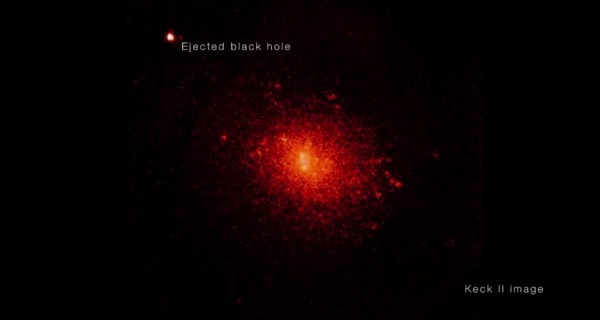Astronomers Stumped by Mystery Object: Black Holes Merging or Rare Supernova?
| Ana Verayo | | Nov 20, 2014 09:28 PM EST |
(Photo : NASA) Ejected black hole or supernova in its final stages?
Astronomers have detected a mysterious, ultra bright object 90 million light years away from Earth that's stimulating their interest and astonishment.
Despite using the Swift telescope, a team of researchers couldn't readily determine if this intense brilliant object is a supermassive black hole made up of merged black holes or is the remnant of a massive star already beginning its supernova phase.
Like Us on Facebook
This object is known as SDSS1133. It's located in the Markarian 177 galaxy and sits in the cup of the Big Dipper. It's has observed by astronomers for more than 60 years.
The object is 40 light years across and at its center is a star formation probably caused by an unknown disturbance in the cosmos.
According to astronomer Michael Koss from ETH Zurich, the data they've acquired still can't determine what this object is. NASA's Swift telescope discovered the brightness of SDSS1133 did change a little in its optical or ultraviolet spectra during the past 10 years. This change isn't common for a young supernova.
This case also suggests that if this object isn't a supernova remnant, it's possible SDSS1133 could be a black hole. What's odd with this theory, however, is the object is located 2,000 light years away from its galaxy's core.
This anomaly could be caused by a merger of two galaxies and their black holes that distorted the galaxies' shapes and triggered massive star formation.
If these two galaxies do contain supermassive black holes, they'll eventually become a binary pair of black holes before merging as one. This also explains why it's so far away from its original galaxy.
As black holes merge, they release massive amounts of energy from gravitational radiation as giant ripples emanating through space-time in every possible direction.
If the black holes vary in size, then the black hole ripples will become stronger. This will make for a lopsided merging where one black hole will be kicked out of its trajectory. This is also the first time scientists have observed this cosmic event.
Apart from being a probable wayward black hole, SDSS1133 could be a rare star called a Luminous Blue Variable (LBV). An LBV is a massive star whose regular eruptions hurl matter and energy through space before it explodes into a giant supernova.
Now, if SDSS1133 is an LBV then its eruptions would have lasted from 1950 to 2001, the longest recorded event of this kind.
TagsMystery Bright Object 90 Million Light Years Away: Ejected Black Hole or Rare Supernova?, NASA, swift telescope, ejected blackhole, blackholes, supernovas, mystery light bright object galaxy rare star ejected blackhole
©2015 Chinatopix All rights reserved. Do not reproduce without permission
EDITOR'S PICKS
-

Did the Trump administration just announce plans for a trade war with ‘hostile’ China and Russia?
-

US Senate passes Taiwan travel bill slammed by China
-

As Yan Sihong’s family grieves, here are other Chinese students who went missing abroad. Some have never been found
-

Beijing blasts Western critics who ‘smear China’ with the term sharp power
-

China Envoy Seeks to Defuse Tensions With U.S. as a Trade War Brews
-

Singapore's Deputy PM Provides Bitcoin Vote of Confidence Amid China's Blanket Bans
-

China warns investors over risks in overseas virtual currency trading
-

Chinese government most trustworthy: survey
-

Kashima Antlers On Course For Back-To-Back Titles
MOST POPULAR
LATEST NEWS
Zhou Yongkang: China's Former Security Chief Sentenced to Life in Prison

China's former Chief of the Ministry of Public Security, Zhou Yongkang, has been given a life sentence after he was found guilty of abusing his office, bribery and deliberately ... Full Article
TRENDING STORY

China Pork Prices Expected to Stabilize As The Supplies Recover

Elephone P9000 Smartphone is now on Sale on Amazon India

There's a Big Chance Cliffhangers Won't Still Be Resolved When Grey's Anatomy Season 13 Returns

Supreme Court Ruled on Samsung vs Apple Dispute for Patent Infringement

Microsoft Surface Pro 5 Rumors and Release Date: What is the Latest?










